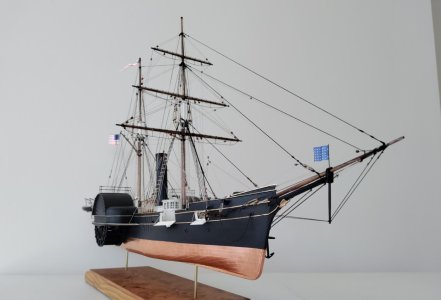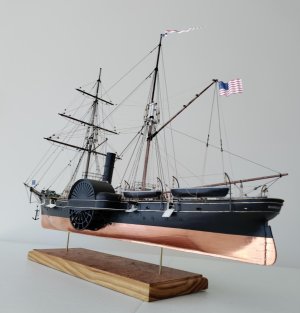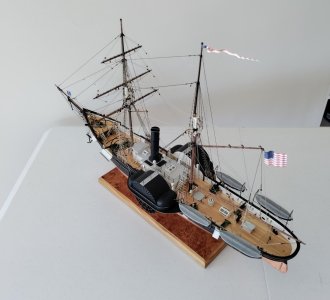Perfect. Then your flags are properly presented.Paul! Correct. No sails. I worked way too hard on the rigging the hide any of it.
-

Win a Free Custom Engraved Brass Coin!!!
As a way to introduce our brass coins to the community, we will raffle off a free coin during the month of August. Follow link ABOVE for instructions for entering.
You are using an out of date browser. It may not display this or other websites correctly.
You should upgrade or use an alternative browser.
You should upgrade or use an alternative browser.
USRC Harriet Lane Model Shipways 1:96 scale circa 1863 COMPLETED
My comment was not about their historic accuracy - but about their orientation. Flags on a sailed vessel blow forward.But what about the additional ensign on the foremast? I am interested in historical accuracy, but I love the flags! As captain of this ship my inclination is to add another one.
Blessings.
Chuck
- Joined
- May 25, 2020
- Messages
- 1,062
- Points
- 443

Paul! Your last post made me laugh! Too early for my grog ration and I did know about the flag orientation question  Flags on sailed vessel's blow forward indeed! In this case, I decided to give the viewer an impression of her speed under steam even though she would not, as @JerryTodd pointed out, be flying her jack under steam.
Flags on sailed vessel's blow forward indeed! In this case, I decided to give the viewer an impression of her speed under steam even though she would not, as @JerryTodd pointed out, be flying her jack under steam.
Blessings.
Chuck
 Flags on sailed vessel's blow forward indeed! In this case, I decided to give the viewer an impression of her speed under steam even though she would not, as @JerryTodd pointed out, be flying her jack under steam.
Flags on sailed vessel's blow forward indeed! In this case, I decided to give the viewer an impression of her speed under steam even though she would not, as @JerryTodd pointed out, be flying her jack under steam. Blessings.
Chuck
That’s looking nice, heading in the wind, Chick.
That’s what Paul saw and also took my eyes.My comment was not about their historic accuracy - but about their orientation. Flags on a sailed vessel blow forward.
Correct with your presentation ‘under steampower’.
Regards, Peter
- Joined
- Jun 29, 2024
- Messages
- 1,380
- Points
- 393

Wonderful job, Chuck!
Roger
Roger
- Joined
- May 25, 2020
- Messages
- 1,062
- Points
- 443

Peter! Aha! It's still funny. I had a student over a while back and he was looking at my Lovely Renee nee Fair American and he said "Cool, but Prof. the flags are blowing the wrong way (forward)" I explained to him that the flag were blowing in the direction of the wind to signal that the ship is also going that way.That’s looking nice, heading in the wind, Chick.
That’s what Paul saw and also took my eyes.
Correct with your presentation ‘under steampower’.
Regards, Peter

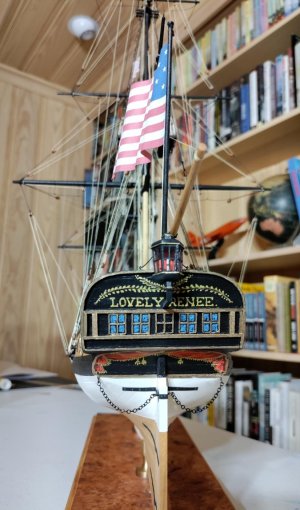
Thank you for looking in!
Blessings.
Chuck
- Joined
- May 25, 2020
- Messages
- 1,062
- Points
- 443

Thank you, Roger! Your thoughts on the additional ensign? Maybe I'll fly it blowing forwardWonderful job, Chuck!
Roger

Blessings.
Chuck
- Joined
- Jun 17, 2021
- Messages
- 3,156
- Points
- 588

On one of my models, a 1:192 schooner yacht "America" with sails, is oriented as though sailing "up", or close, the wind. On the model I oriented the sails blowing forward. Then a more knowledgeable model maker and sailor pointed out that the sails orient to the direction of the wind and that on my model they were oriented all but backwards! We just laughed and allowed that there was maybe a shifting gust at that moment.
Anyway, the Annapolis Marine Art Gallery sold the model and she's sailing around on somebody's yacht from England.
There are pictures of her floating around here somewhere on SoS.
"Harriet" is looking very glamorous!!


Anyway, the Annapolis Marine Art Gallery sold the model and she's sailing around on somebody's yacht from England.
There are pictures of her floating around here somewhere on SoS.
"Harriet" is looking very glamorous!!



- Joined
- May 25, 2020
- Messages
- 1,062
- Points
- 443

Pete! I love it!!! Thank you for sharing your shifting winds story! Must be another Pete Gutterman pearl!On one of my models, a 1:192 schooner yacht "America" with sails, is oriented as though sailing "up", or close, the wind. On the model I oriented the sails blowing forward. Then a more knowledgeable model maker and sailor pointed out that the sails orient to the direction of the wind and that on my model they were oriented all but backwards! We just laughed and allowed that there was maybe a shifting gust at that moment.
Anyway, the Annapolis Marine Art Gallery sold the model and she's sailing around on somebody's yacht from England.
There are pictures of her floating around here somewhere on SoS.
"Harriet" is looking very glamorous!!
Any thoughts on the additional ensign - I wonder if I can get away with it as historically not incorrect imagining the ship is passing in review?
Blessings.
Chuck
- Joined
- Jun 17, 2021
- Messages
- 3,156
- Points
- 588

It' YOUR ship, Captain, do what makes you happy! 
You make me happy that you thought about this carefully on both!Peter! Aha! It's still funny. I had a student over a while back and he was looking at my Lovely Renee nee Fair American and he said "Cool, but Prof. the flags are blowing the wrong way (forward)" I explained to him that the flag were blowing in the direction of the wind to signal that the ship is also going that way.
View attachment 515018View attachment 515019
Thank you for looking in!
Blessings.
Chuck
Regards, Peter
Good afternoon Chuck. Wow stunning pics of a beautiful model- you owned this. I missed these posts so apologies for my late response. Cheers GrantHow about a few more pics? You got it!
View attachment 515016View attachment 515017View attachment 515015
Hi Chuck,
Beautiful work on your Harriet Lane. She turned out great!
Bill
Beautiful work on your Harriet Lane. She turned out great!
Bill
- Joined
- Jun 29, 2024
- Messages
- 1,380
- Points
- 393

A beautiful model!
Well done,
Roger
Well done,
Roger
Congratulations! Amazing final result with the Harriete Lane "The Gavel". It´s a really good work!How about a few more pics? You got it!
View attachment 515016View attachment 515017View attachment 515015
- Joined
- May 25, 2020
- Messages
- 1,062
- Points
- 443

What ho, shipmates!
Shortly, I'll post the finale of of my Harriet Lane build. Keel laid: December 3, 2023. Commissioned: May 18, 2025. So, fill up your tumblers with your favorite form of grog and take a comfortable chair!
Blessings. Peace. Gratitude.
Chuck
Shortly, I'll post the finale of of my Harriet Lane build. Keel laid: December 3, 2023. Commissioned: May 18, 2025. So, fill up your tumblers with your favorite form of grog and take a comfortable chair!
Blessings. Peace. Gratitude.
Chuck
- Joined
- May 25, 2020
- Messages
- 1,062
- Points
- 443

William Webb designed and built Harriet Lane for as a Revenue Service Cutter in 1957. She made her first transfer to the U.S. Navy in 1858 and joined a squadron in route to Paraguay to negotiate a settlement of the unprovoked attack on Waterwitch by Paraguay in 1855. After that successful cruise, she returned to the Revenue Service until the out break of the Civil War.
Harriet Lane again transferred to the Navy on March 30, 1861 and remained in the Navy until she was lost to Confederate forces in the Second Battle of Galveston on January 1, 1863. She started her service as part of the squadron sent to resupply Fort Sumpter where she fired the first United States shots of the Civil War. She was part of every major naval engagement between 1861 and her loss in 1863. Harriet Lane was heavily damaged twice. First, during her service against Confederate positions on the outer banks of North Carolina in August, 1861. She ran aground attempting to enter Pamlico Sound through the Hatteras Inlet on August 29, 1861. She was refloated at the cost of her guns and everything else that could be jettisoned. Second, in February, 1862, she was sailing to Hampton Roads to join Porter's Mortar Flotilla at Key West when she was taken under fire by a Confederate battery at Shipping Point, Virginia. The battery fire damaged her port wheel, delaying her arrival at Key West. In late February, however, she captured the Confederate schooner Joanna Ward off the Florida coast.
Harriet Lane was Porter's flagship when his flotilla supported Admiral Farragut's dash past the New Orleans' forts to enter the Mississippi in late April, 1862. On April 29, Harriet Lane steamed up the Mississippi to accept the surrender of the upstream river forts. The Navy had been using Ship Island as a repair and supply base. Harriet Lane went there on May 30, 1862. She was to have played a role in the reduction of Vicksburg, but without sufficient ground forces, Farragut was forced to abandon the attack on that stronghold for the moment.
The First Battle of Galveston, October 3, 1862, saw Harriet Lane victorious. She bombarded and captured the port with the aid of the Westfield, Owasoo, Clifton, and Henry James. Although it remains unclear, it seems that her repairs, perhaps at Ship Island, saw her refitted to the version I built with a 30lbr Parrot Rifle on a raised foredeck and a forward IX inch Dahlgren in addition to her broadside guns aft comprised of two IX inch Dahlgrens on Marsilly carriages and two 24lbr howitzers. I hope one or more of our shipmates will add their expertise. Looking at you in particular @Peter Gutterman and @JerryTodd.
Unfortunately, the capture of Galveston was not well supported by ground forces. It was equally unfortunate that Confederate Major General John Bankhead Magruder arrived in Texas in late October 1862. General Magruder planned and executed the successful recapture of Galveston which remained in Confederate hands until the end of the war.
The attack began late on December 31, 1862. Dawn on January 1, 1863 saw Harriet Lane engaged with two Confederate cotton clads, the Bayou City and the Neptune. First, Bayou City fired its 32lbr rifle into Harriet Lane causing serious damage. Then Neptune rammed Harriet Lane. Next, Bayou City, having circled around, rammed Harriet Lane as well. Both Confederate ships had been fitted with corvuses which were lowered to allow Confederate troops to board and overwhelm Harriet Lane's crew. Her captain, Commander. J. M. Wainwright and executive officer, Lt. Commander. Edward Lea, were killed in action that day defending their ship. Lt. Cmdr. Lea, USN, was the son of Major Albert M. Lea, CSA. Major Lea was one of General Magruder's aides. He found his wounded son on Harriet Lane's deck. As the major comforted his son, the young man told his father, "You have seen that I have done my duty to the last and died fighting for my country, Tell them at home that I love them."
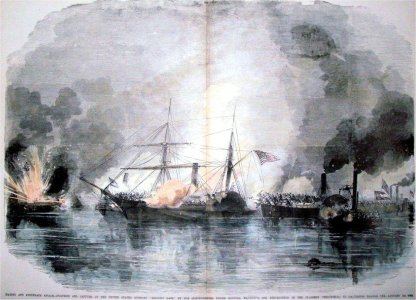
After the battle, Harriet Lane was taken into the Confederate Army's Maritime Department of Texas. She was ultimately sold, converted into a Confederate blockade runner and renamed Lavinia. She escaped Galveston in late April , 1864 and sailed to Havana where she was interned for the duration. History tells us that she was recovered from Cuba in 1867, converted to a bark rig and renamed Elliott Ritchie. She lost the number of her mess when she was abandoned off Pernambuco, Brazil on May 13, 1884.
Harriet Lane again transferred to the Navy on March 30, 1861 and remained in the Navy until she was lost to Confederate forces in the Second Battle of Galveston on January 1, 1863. She started her service as part of the squadron sent to resupply Fort Sumpter where she fired the first United States shots of the Civil War. She was part of every major naval engagement between 1861 and her loss in 1863. Harriet Lane was heavily damaged twice. First, during her service against Confederate positions on the outer banks of North Carolina in August, 1861. She ran aground attempting to enter Pamlico Sound through the Hatteras Inlet on August 29, 1861. She was refloated at the cost of her guns and everything else that could be jettisoned. Second, in February, 1862, she was sailing to Hampton Roads to join Porter's Mortar Flotilla at Key West when she was taken under fire by a Confederate battery at Shipping Point, Virginia. The battery fire damaged her port wheel, delaying her arrival at Key West. In late February, however, she captured the Confederate schooner Joanna Ward off the Florida coast.
Harriet Lane was Porter's flagship when his flotilla supported Admiral Farragut's dash past the New Orleans' forts to enter the Mississippi in late April, 1862. On April 29, Harriet Lane steamed up the Mississippi to accept the surrender of the upstream river forts. The Navy had been using Ship Island as a repair and supply base. Harriet Lane went there on May 30, 1862. She was to have played a role in the reduction of Vicksburg, but without sufficient ground forces, Farragut was forced to abandon the attack on that stronghold for the moment.
The First Battle of Galveston, October 3, 1862, saw Harriet Lane victorious. She bombarded and captured the port with the aid of the Westfield, Owasoo, Clifton, and Henry James. Although it remains unclear, it seems that her repairs, perhaps at Ship Island, saw her refitted to the version I built with a 30lbr Parrot Rifle on a raised foredeck and a forward IX inch Dahlgren in addition to her broadside guns aft comprised of two IX inch Dahlgrens on Marsilly carriages and two 24lbr howitzers. I hope one or more of our shipmates will add their expertise. Looking at you in particular @Peter Gutterman and @JerryTodd.
Unfortunately, the capture of Galveston was not well supported by ground forces. It was equally unfortunate that Confederate Major General John Bankhead Magruder arrived in Texas in late October 1862. General Magruder planned and executed the successful recapture of Galveston which remained in Confederate hands until the end of the war.
The attack began late on December 31, 1862. Dawn on January 1, 1863 saw Harriet Lane engaged with two Confederate cotton clads, the Bayou City and the Neptune. First, Bayou City fired its 32lbr rifle into Harriet Lane causing serious damage. Then Neptune rammed Harriet Lane. Next, Bayou City, having circled around, rammed Harriet Lane as well. Both Confederate ships had been fitted with corvuses which were lowered to allow Confederate troops to board and overwhelm Harriet Lane's crew. Her captain, Commander. J. M. Wainwright and executive officer, Lt. Commander. Edward Lea, were killed in action that day defending their ship. Lt. Cmdr. Lea, USN, was the son of Major Albert M. Lea, CSA. Major Lea was one of General Magruder's aides. He found his wounded son on Harriet Lane's deck. As the major comforted his son, the young man told his father, "You have seen that I have done my duty to the last and died fighting for my country, Tell them at home that I love them."

After the battle, Harriet Lane was taken into the Confederate Army's Maritime Department of Texas. She was ultimately sold, converted into a Confederate blockade runner and renamed Lavinia. She escaped Galveston in late April , 1864 and sailed to Havana where she was interned for the duration. History tells us that she was recovered from Cuba in 1867, converted to a bark rig and renamed Elliott Ritchie. She lost the number of her mess when she was abandoned off Pernambuco, Brazil on May 13, 1884.
- Joined
- May 25, 2020
- Messages
- 1,062
- Points
- 443

And now shipmates, my Harriet Lane completed. You'll probably notice that I decided to redo the jack, ensign and pennant, They were all a bit too small and dim. As to the pennant in particular, the first version seemed gravity resistant, but I was worried about having a droopy pennant. So, on the final version, I sandwiched a piece of 28 gauge wire between the halves of the pennant.
Before the final photo parade - First, thanks to @Model Shipways for producing this lovely kit! Thanks to Pete Gutterman for inspiring me to build her in her final iteration and to Jerry Todd for his deep expertise and the 3D prints of the guns! Never could have achieved this result without you! Thanks to Paul, Grant, Roger, Bill, Peter and my other shipmates for your support and kind observations! Second, I apologize for the quality of the pictures. I wish that some of our master builders, who are also master photographers (looking at you Paul, Grant and Peter!!!) lived next door and could just come over.
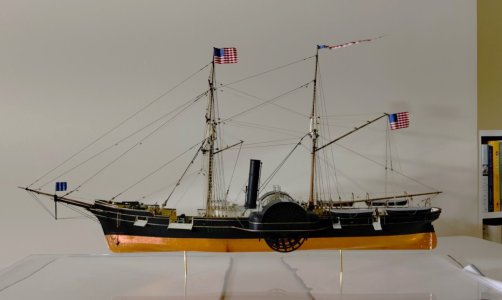
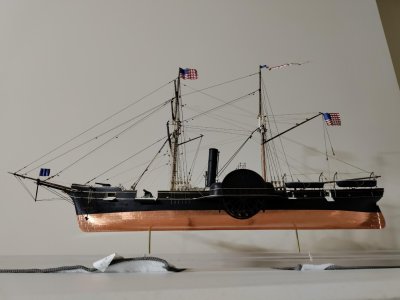
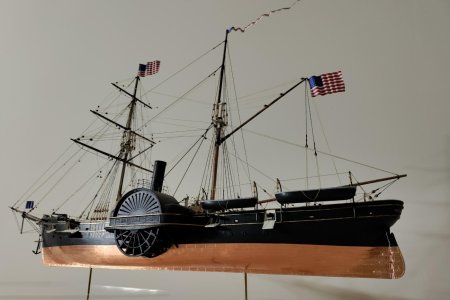
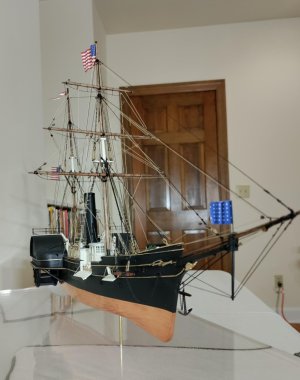
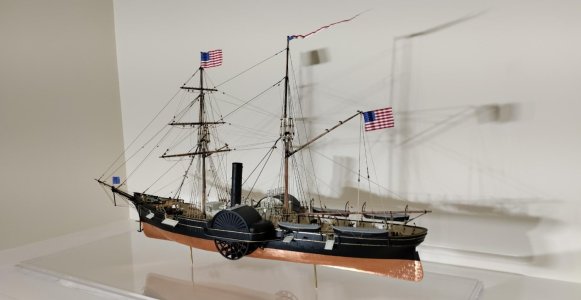
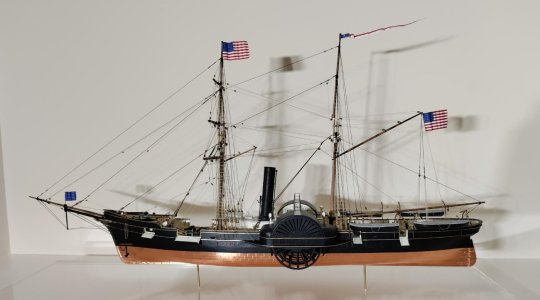
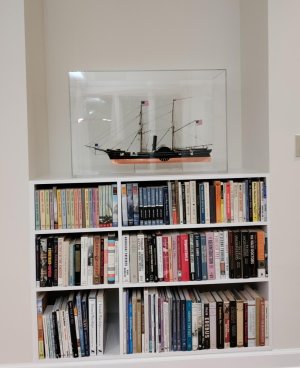
Ta da!!!!
Thanks again, shipmates!
Blessings. Peace. Gratitude.
Chuck
Before the final photo parade - First, thanks to @Model Shipways for producing this lovely kit! Thanks to Pete Gutterman for inspiring me to build her in her final iteration and to Jerry Todd for his deep expertise and the 3D prints of the guns! Never could have achieved this result without you! Thanks to Paul, Grant, Roger, Bill, Peter and my other shipmates for your support and kind observations! Second, I apologize for the quality of the pictures. I wish that some of our master builders, who are also master photographers (looking at you Paul, Grant and Peter!!!) lived next door and could just come over.








Ta da!!!!
Thanks again, shipmates!
Blessings. Peace. Gratitude.
Chuck


